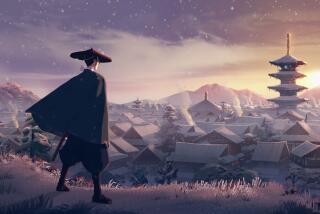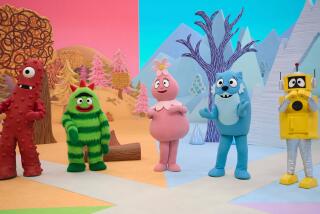From the Archives: Our 1995 review: ‘Toy Story’ visuals delight kids, while adults will appreciate the wised-up jokes
Animation has come a long way in the last two decades. The Times’ movie critic Kenneth Turan reviewed “Toy Story” when it came out 20 years ago, calling it a “captivating first step along animation’s most promising new frontier.” This story first appeared in print on Nov. 22, 1995.
Guilt. Envy. Nervous breakdowns and rampant neuroses. If you’ve ever thought that toys had an easy life, “Toy Story” will set you straight.
Although its computer-generated imagery is impressive, the major surprise of this bright foray into a new kind of animation is how much cleverness has been invested in story and dialogue. Usually when a film credits seven writers, it’s not a positive sign, but “Toy Story” turns out to be smart fun on a verbal as well as visual level.
Those writers (Joss Whedon, Andrew Stanton, Joel Cohen & Alec Sokolow, from a story by Stanton, director John Lasseter, Peter Docter and Joe Ranft) have kept “Toy Story” true to what has become one of Disney’s most successful formulas, visible in everything from “Aladdin” to “The Nightmare Before Christmas”: Supply enough on-screen pratfalls and visual dazzle to keep the kids occupied while luring the adults with feisty characterizations and wised-up jokes about “laser envy” and plastic corrosion awareness meetings.
What is special about “Toy Story” is that although “Tin Toy,” a short co-directed by Lasseter, won an Oscar in 1988, this is the first time that computer-generated animation has been successfully stretched to feature length.
By giving its normally inanimate protagonists a magical three-dimensional quality, “Toy Story” creates the kind of gee-whiz enchantment that must have surrounded “Snow White” on its initial release. True, computer imagery still has trouble creating people that don’t look like space aliens, but this film compensates by sensibly shoving the humans to the background and focusing on those darn toys.
SIGN UP for the free Indie Focus movies newsletter >>
Echoing a concept at least as old as Tchaikovsky’s “The Nutcracker,” “Toy Story” showcases toys springing to life when people aren’t around. But rather than being idle playthings, these toys, the possessions of a small boy named Andy, turn out to be careworn adults, easily overwhelmed by worries and woes.
Rex, the toy dinosaur (Wallace Shawn), is in the grip of a crisis of confidence, worried that while he’s “going for fearsome, it just comes off as annoying.” Bo Peep (Annie Potts) fears her come-hither looks are being wasted, and gruff Mr. Potato Head (Don Rickles) alternates between grousing about mistreatment at the hands of Andy’s infant sister (“ages 3 and up; it’s on my box”) to yearning for a Mrs. Potato Head to end his solitude.
Riding herd over these troubled folks is Woody (Tom Hanks), an old-fashioned floppy pull-string toy that has been Andy’s favorite forever. So while the others worry that they’ll turn into “next month’s garage sale fodder” when new toys appear on the scene, Woody tries to calm them down with a pep talk about “being here for Andy when he needs us.”
But the birthday party that opens the film turns out to be a serious shock to Woody. Andy is given a Buzz Lightyear space ranger action figure, complete with “more gadgets than a Swiss army knife,” and it begins to look as if there’s a new top toy in town.
Given to saying “to infinity, and beyond” at slight provocation, Buzz (Tim Allen) is one of “Toy Story’s” pleasant surprises, because, unlike the rest of Andy’s possessions, he doesn’t realize that he really is a toy. Self-absorbed and delusional, given to fatuous pronouncements like “I come in peace,” Buzz thinks he is a genuine space ranger, on a mission to save the universe from the menacing Emperor Zurg.
All this drives Woody crazy, as does the fact that Buzz’s presence increasingly places his position as Andy’s favorite toy in jeopardy. As “Toy Story” amusingly progresses, both Woody and Buzz confront these unpleasant realities and face the discomforting need to cooperate with each other to save themselves from a variety of troubles.
Starting with Tom Hanks, who brings an invaluable heft and believability to Woody, “Toy Story” is one of the best voiced animated features in memory, with all the actors (as well as Randy Newman, who contributed three songs and the score) making their presences strongly felt.
Continuously inventive, “Toy Story” has a number of cheerful set pieces that keep it lively. One of the cleverest is a visit to the fast-food Pizza Planet, where Buzz and Woody end up inside a kind of gum-ball machine whose inhabitants worship the claw that conveys them to the outside world. It’s a deft, wacky sequence, complete with Woody shouting, “Stop it, you zealots,” at the three-eyed figures, and it typifies why “Toy Story” is a captivating first step along animation’s most promising new frontier.
* MPAA rating: G. Times guidelines: toys in jeopardy, toys attempting to do harm to other toys, a sadistic boy next door who tortures toys and much humor that is intended for adults.
More to Read
Only good movies
Get the Indie Focus newsletter, Mark Olsen's weekly guide to the world of cinema.
You may occasionally receive promotional content from the Los Angeles Times.










